Metadata
| Name | Neuromuscular dysfunction of bladder (neuro_bladder) |
| Category | Genitourinary |
| Sex | |
| Adult | Yes |
| UUID | a6a981ea-3ca1-4a54-aed7-7068bc812d8a |
| Definition | Dysfunction of the URINARY BLADDER due to disease of the central or peripheral nervous system pathways involved in the control of URINATION. |
Ontologies
| Disease Ontology (DOID) | DOID_12143 |
| MeSH | D001750 |
| SNOMED-CT | 397732007 |
| FinnGen | N14_NEUROMUSCDYSBLADD |
Key Summary Statistics
Cases from any source
| Total | 5707 |
| Female (%) | 3472 (61%) |
| Male (%) | 2235 (39%) |
Year first recorded
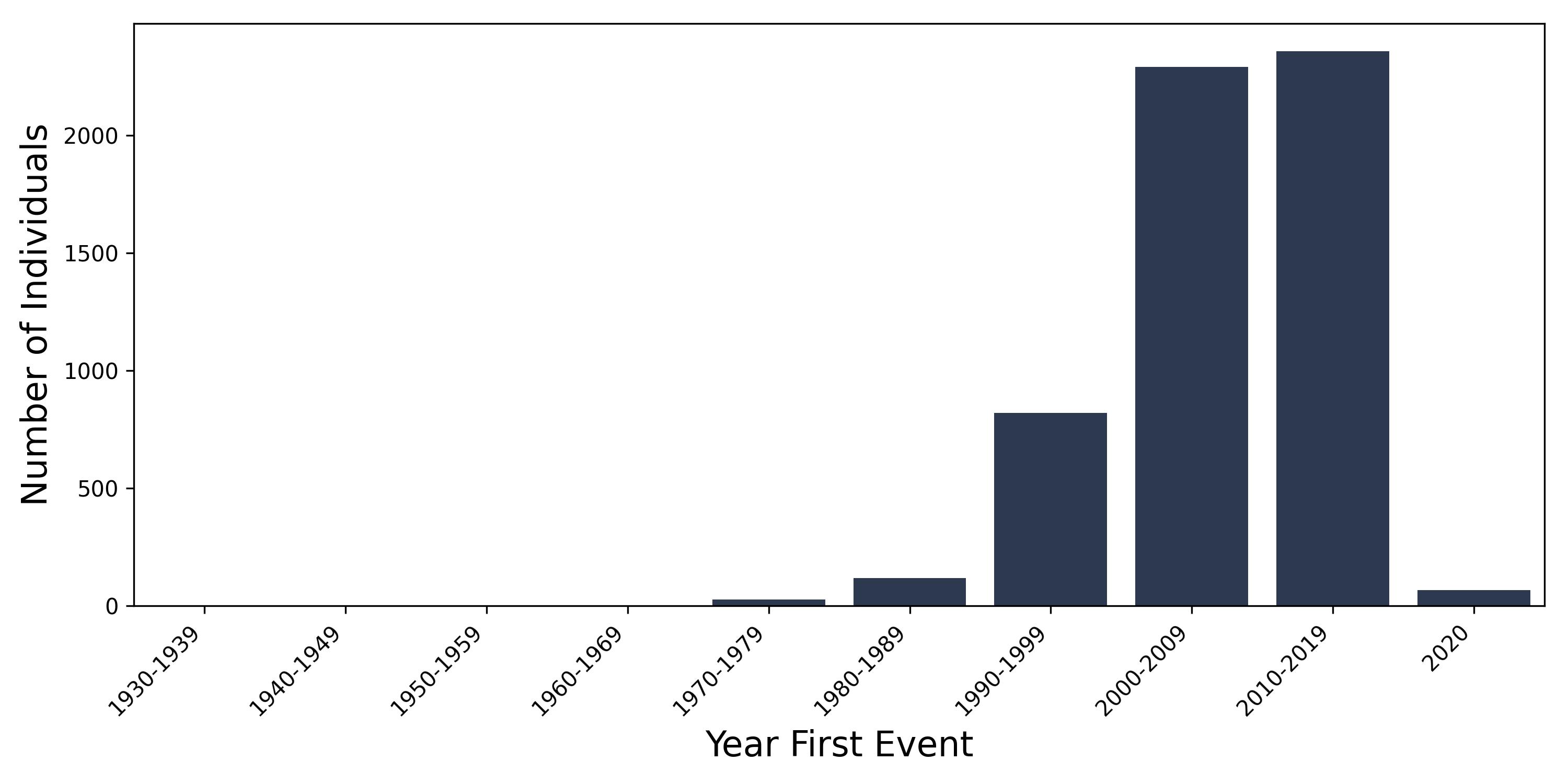
Cases linked in all UK Biobank sources
Cross-source concordance
Vertical bars correspond to number of cases per source/intersection; horizontal bars to left correspond to total number of cases per source.
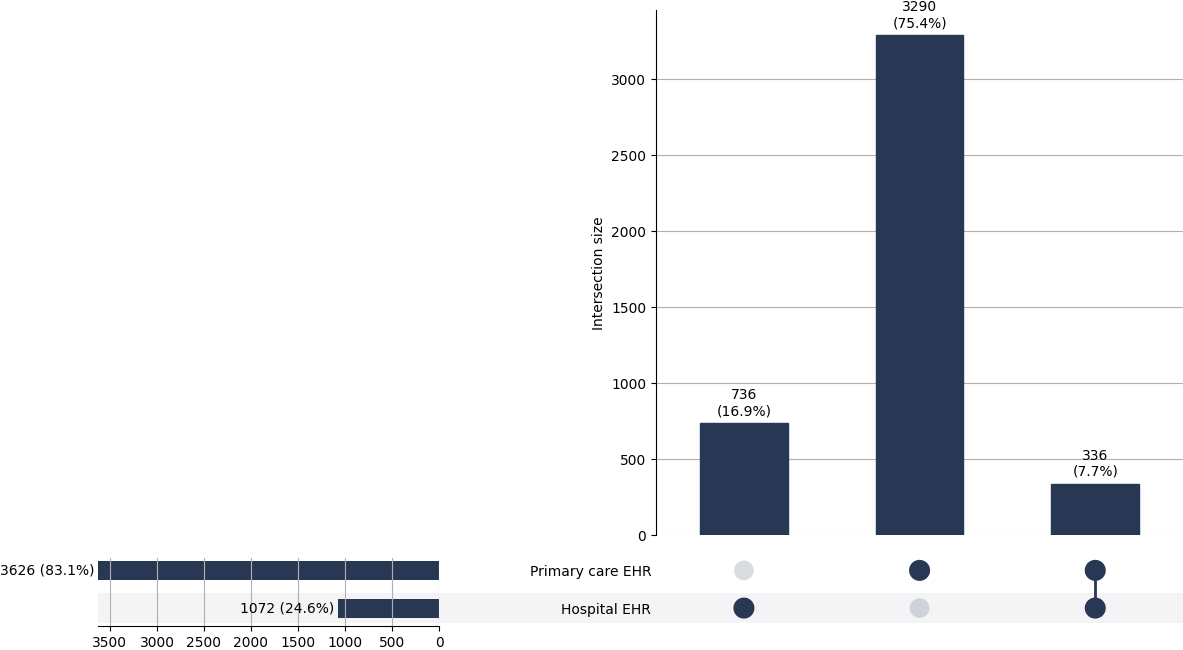
Incidence & prevalence
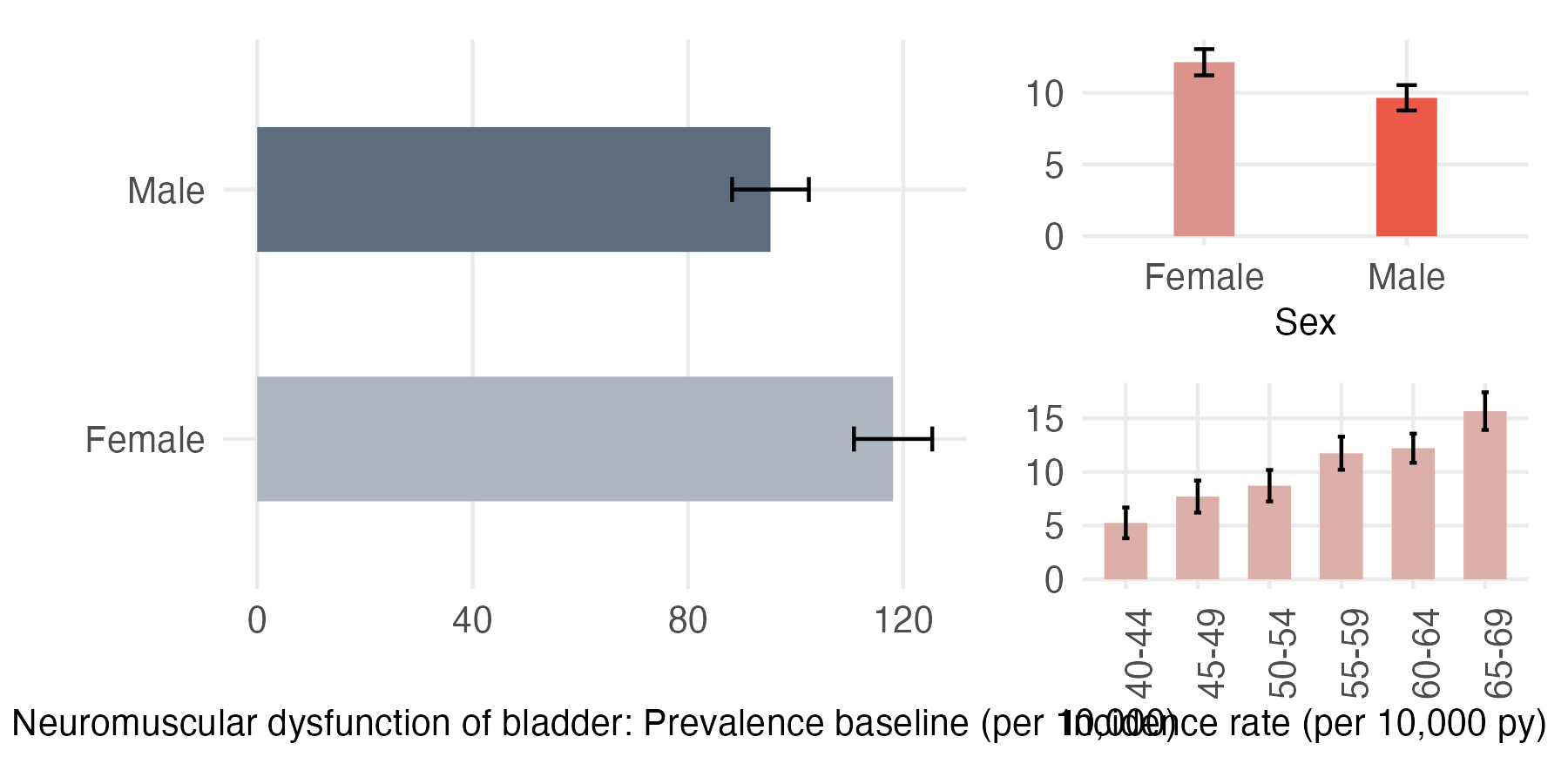
Baseline prevalence stratified by sex
| Female | 118.11 (110.84,125.38) |
| Male | 95.34 (88.21,102.46) |
Incidence stratified by sex
| Female | 12.14 (11.22,13.05) |
| Male | 9.65 (8.77,10.54) |
Incidence stratified by age
| Ages 40-44 | 5.26 (3.83,6.69) |
| Ages 45-49 | 7.71 (6.22,9.2) |
| Ages 50-54 | 8.72 (7.26,10.19) |
| Ages 55-59 | 11.75 (10.21,13.29) |
| Ages 60-64 | 12.22 (10.86,13.57) |
| Ages 65-69 | 15.67 (13.92,17.43) |
Period prevalence
Methods
Comparison with general population
Sex-standardised prevalence from CALIBER study (Kuan et al. 2019)
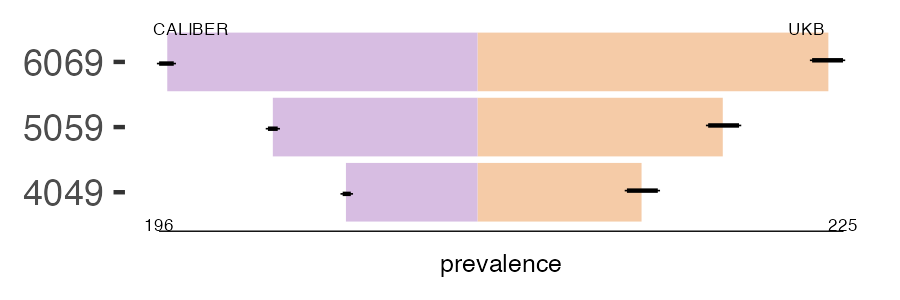
| Population | Ages 40-49 | Ages 50-59 | Ages 60-69 |
| UK Biobank | 101 (92,111) | 151 (142,161) | 216 (206,225) |
| CALIBER | 81 (78,83) | 126 (123,129) | 191 (187,196) |
Stratified by age and Townsend deprivation status
| Deprivation status | Ages 40-49 | Ages 50-59 | Ages 60-69 |
| Least deprived | 93(72,118) | 133(114,154) | 217(197,239) |
| Low | 83(63,107) | 126(107,146) | 193(174,213) |
| Medium | 92(72,115) | 163(142,186) | 191(171,211) |
| High | 90(71,111) | 137(118,158) | 225(203,248) |
| Most deprived | 137(115,161) | 199(176,224) | 262(237,288) |
Stratified by age and country
| Country | Ages 40-49 | Ages 50-59 | Ages 60-69 |
| England | 103(92,114) | 150(140,161) | 221(210,232) |
| Scotland | 106(80,138) | 175(149,205) | 237(209,268) |
| Wales | 80(52,119) | 124(97,158) | 127(102,157) |
Risk factors analysis
‘Healthy’ BMI, smoking status ‘never’, or no hypertension (absence of hypertension records) were considered as reference values.
Hazard Ratio (HR) values with P < 0.0002 were considered to show significant association with disease onset after correction for multiple-testing using the Bonferroni method
N=153321, Events=259
| Factor | Level | Hazard Ratio | P value |
| BMI | overweight | 1.47 (1.07, 2.01) | 0.0165 |
| BMI | obese | 2.46 (1.81, 3.35) | 1.19e-08 |
| BMI | underweight | 0 (0, Inf) | 0.998 |
| smoking | previous | 1.06 (0.81, 1.39) | 0.676 |
| smoking | current | 0.75 (0.46, 1.22) | 0.25 |
| hypertension | yes | 0.83 (0.58, 1.19) | 0.31 |
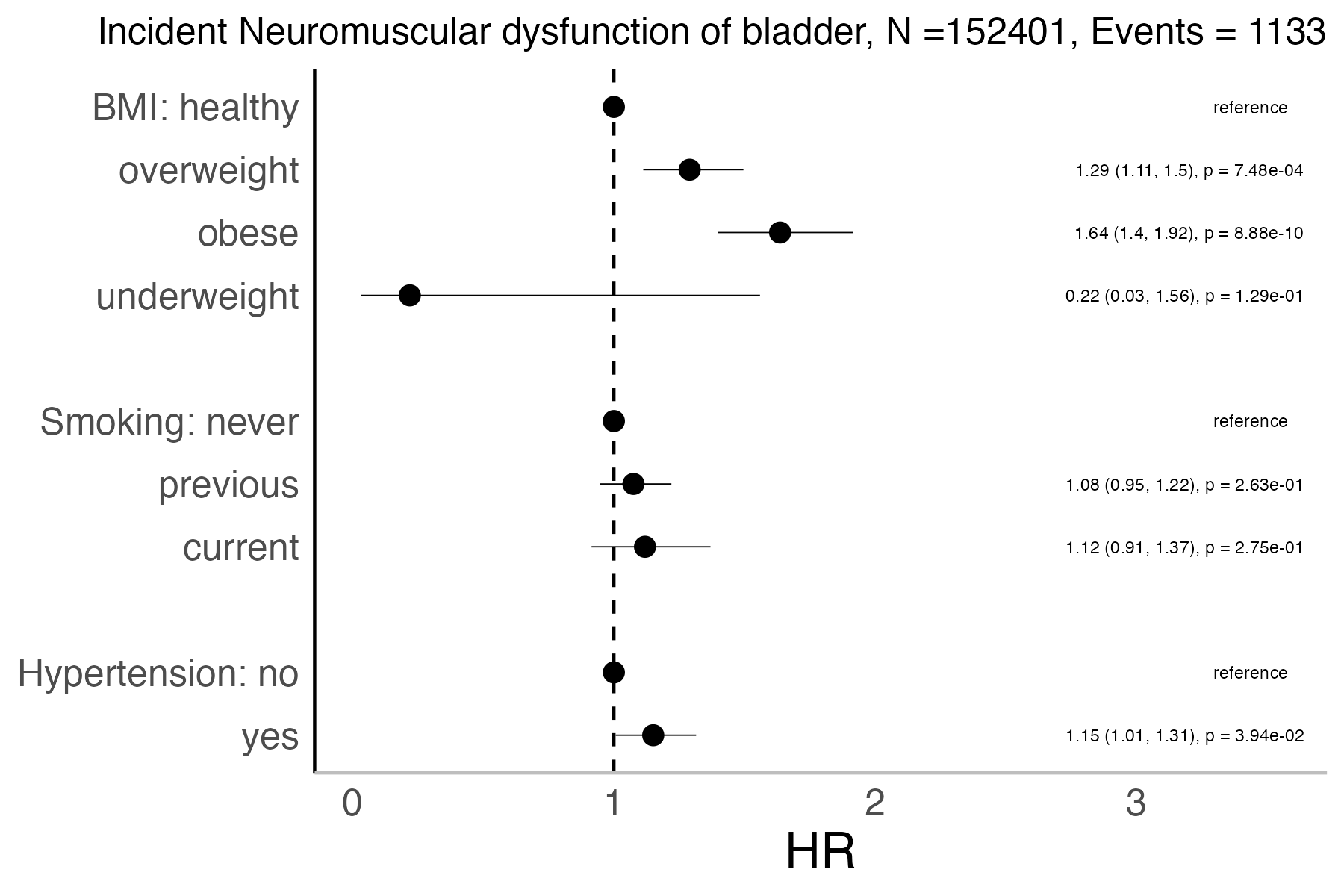
Definition
| UK Biobank field id | Description | Code | Value |
|---|---|---|---|
| 41202 | Diagnoses - main ICD10 | N31 | Neuromuscular dysfunction of bladder, not elsewhere classified |
| 41204 | Diagnoses - secondary ICD10 | N31 | Neuromuscular dysfunction of bladder, not elsewhere classified |
| 40001 | Underlying (primary) cause of death: ICD10 | N31 | Neuromuscular dysfunction of bladder, not elsewhere classified |
| 40002 | Contributory (secondary) causes of death: ICD10 | N31 | Neuromuscular dysfunction of bladder, not elsewhere classified |
| 42040 | GP clinical event records | F246111 | Atonic bladder |
| 42040 | GP clinical event records | F246112 | Neurogenic bladder |
| 42040 | GP clinical event records | F246113 | Neuropathic bladder |
| 42040 | GP clinical event records | K164000 | Hypotonic bladder |
| 42040 | GP clinical event records | K164100 | Bladder inertia |
| 42040 | GP clinical event records | K164.00 | Atony of bladder |
| 42040 | GP clinical event records | K164.11 | Atonic bladder |
| 42040 | GP clinical event records | K164z00 | Atony of bladder NOS |
| 42040 | GP clinical event records | K165000 | Hypertonic bladder sphincter |
| 42040 | GP clinical event records | K165100 | Bladder sphincter paralysis |
| 42040 | GP clinical event records | K165300 | Detrusor instability |
| 42040 | GP clinical event records | K165400 | Unstable bladder |
| 42040 | GP clinical event records | K165.00 | Other functional disorder of bladder |
| 42040 | GP clinical event records | K165z00 | Other bladder function disorder NOS |
| 42040 | GP clinical event records | K16V000 | Neuropathic bladder |
| 42040 | GP clinical event records | K16V011 | Neurogenic bladder |
| 42040 | GP clinical event records | K16V100 | Overactive bladder |
| 42040 | GP clinical event records | K16V.00 | Neuromuscular dysfunction of bladder, unspecified |
| 42040 | GP clinical event records | K16W.00 | Reflex neuropathic bladder, not elsewhere classified |
| 42040 | GP clinical event records | K16X.00 | Uninhibited neuropathic bladder, NEC |
| 42040 | GP clinical event records | K16y400 | Irritable bladder |
| 42040 | GP clinical event records | K16y411 | Detrusor instability |
| 42040 | GP clinical event records | K16y412 | Unstable bladder |
| 42040 | GP clinical event records | K16y800 | Functional disorder of bladder |
| 42040 | GP clinical event records | K16y811 | Functional voiding disorder |
| 42040 | GP clinical event records | Kyu5200 | [X]Other neuromuscular dysfunction of bladder |
| 42040 | GP clinical event records | Kyu5E00 | [X]Neuromuscular dysfunction of bladder, unspecified |
| 42040 | GP clinical event records | X30Nj | Neuropathic bladder |
| 42040 | GP clinical event records | X30Ni | Functional disorder of bladder |
| 42040 | GP clinical event records | K16y4 | Detrusor instability |
| 42040 | GP clinical event records | XE15W | Cauda equina syndrome with cord bladder |